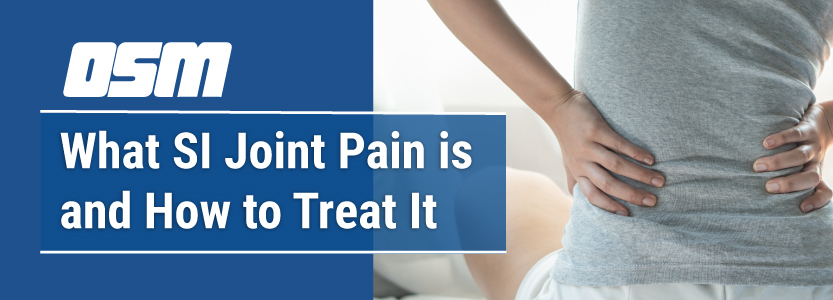Article featured on Summit Orthopedics
What is the SI joint?
The sacroiliac joint, more commonly known as the SI joint, is where the pelvis meets the bottom of the spine. That joint can get irritated, and there is a major nerve that sits on top of this joint. If the joint is irritated, then often the nerve will get irritated also, causing broad pain in that region.
It’s a complex diagnosis because pain in this area can also be referred pain from issues in the spinal canal.
What causes SI joint pain?
Pain in the SI joint is fairly common and can be caused by many different things. For example, the joint can get irritated by abnormal movement patterns. For example, if you’re recovering from ankle surgery or have heel pain, you may be walking differently than you typically do. That can cause SI joint pain.
Another common cause of SI joint pain is previous back surgery, particularly in the lower back (lumbar spine).
What are some common SI joint pain symptoms?
- The most common symptom is pain in the buttock, usually on one side.
- The pain can radiate down to the knee or to the groin, but it’s typically the low buttock and slightly below that.
- The area can be quite tender if you push on it.
How can I treat my SI joint pain?
There is good news for people dealing with SI joint pain. There are lots of great, effective treatment options that don’t require surgery:
- Physical therapy can work well. There are a variety of exercises for SI joint pain to reduce the irritation and the associated symptoms.
- Steroid injections can be effective. It allows the physician to deliver strong anti-inflammatory medicine directly to the joint.
- Specialized equipment, particularly a belt brace, can help to stabilize the joint.
- Prolotherapy is an innovative treatment option that research shows can be even more effective than a steroid injection at relieving pain. Rather than injecting steroids, the provider injects a kind of sugar water, which causes a low level of irritation that prompts the body’s natural healing mechanism to activate.
- Regenerative medicine techniques can also work well, such as injecting platelet-rich plasma in and around the joint to decrease irritation.
- Radiofrequency ablation can be an option, ablating the nerves to “turn off” pain to the SI joint.
Many people present with what they think is SI joint area pain. Because it is difficult to diagnose, those patients benefit from an expert consultation to make sure the problem is actually with the SI joint, because it masquerades as quite a few things.
The Orthopedic & Sports Medicine Center of Oregon is an award-winning, board-certified orthopedic group located in downtown Portland Oregon. We utilize both surgical and nonsurgical means to treat musculoskeletal trauma, spine diseases, foot and ankle conditions, sports injuries, degenerative diseases, infections, tumors and congenital disorders.
Our mission is to return our patients back to pain-free mobility and full strength as quickly and painlessly as possible using both surgical and non-surgical orthopedic procedures.
Our expert physicians provide leading-edge, comprehensive care in the diagnosis and treatment of orthopedic conditions, including total joint replacement and sports medicine. We apply the latest state-of-the-art techniques in order to return our patients to their active lifestyle.
If you’re looking for compassionate, expert orthopedic and podiatric surgeons in Portland Oregon, contact OSM today.
Phone:
503-224-8399
Address
17355 Lower Boones Ferry Rd Suite 100A
Lake Oswego, OR 97035
Hours
Monday–Friday
8:00am – 4:30pm



